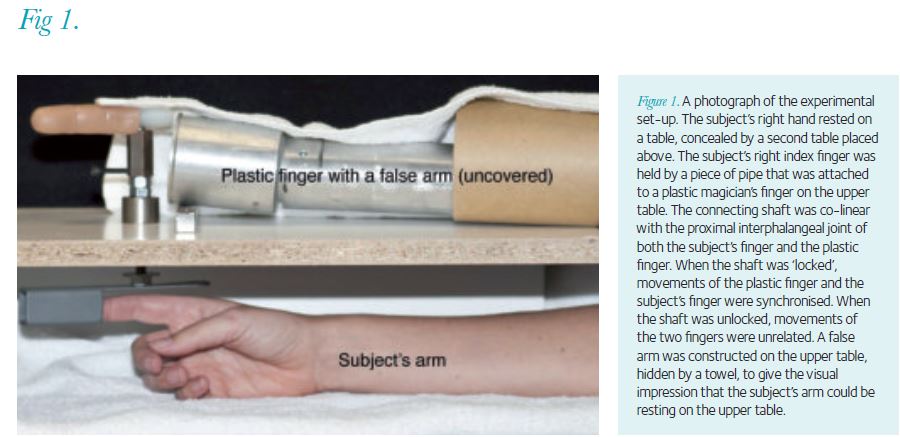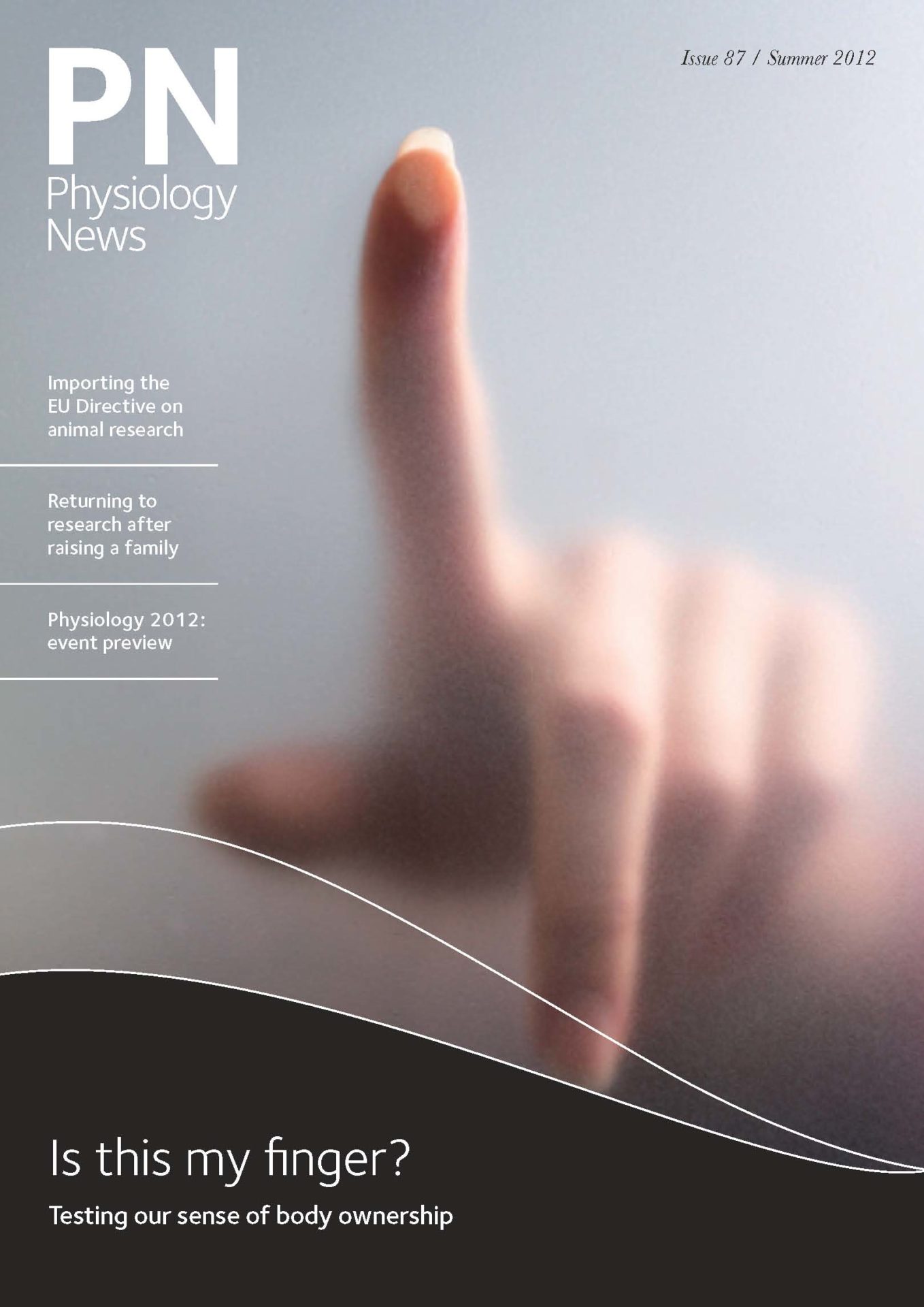
Physiology News Magazine
Is this my finger?
We know our body is ours, but which signals does the brain use to work out which things are part of ’us’ and which things are not?
Features
Is this my finger?
We know our body is ours, but which signals does the brain use to work out which things are part of ’us’ and which things are not?
Features
Lee Walsh, G Lorimer Moseley, Janet Taylor, Simon Gandevia
Neuroscience Research Australia and the University of New South Wales
https://doi.org/10.36866/pn.87.27
Healthy people know which things are part of their body and which things are not. For example, when we look down at our hands we know that they are ‘ours’, a part of our body, but we also know that the table on which the hands are resting is not part of our body.
We know that a hand we shake is not ours. We can make these judgements because the brain maintains representations of the body that store information such as body size, limb position and body ‘ownership’. Presumably these representations are built up and maintained using sensory information, but it is not always obvious which sensory signals are involved. We have a clear sense of ‘ownership’, but there is no peripheral receptor for ‘ownership’. Which sensory signals the brain uses to generate a sense of ownership, and how they combine and interact with one another is not well understood. Clinical conditions, in which the sense of ownership of parts of the body is disrupted, range from patients who neglect a limb (for example, following a stroke) or suffer chronic pain and report that the painful limb is not theirs, to patients who request (or attempt) amputation of a healthy limb because they feel that it is not theirs and they find it alien and offensive. Treatment of these conditions requires better understanding of the mechanisms contributing to the sense of ownership and how they can be disrupted.
For something so obviously personal, it is surprising that the sense of body ownership is easily manipulated, and so one way to investigate this sense is to induce illusions of body ownership. The most common and well-known illusion is referred to as the ‘rubber hand’ illusion, first described by Botvinick and Cohen (1998). It involves making subjects perceive an artificial rubber hand as being their own. The rubber hand illusion is typically induced with combined visual and tactile stimulation, in which a rubber hand and the subject’s hand are brushed with synchronous strokes while the subject looks at the rubber hand but not at their own. After the rubber hand illusion develops, the subject will report that they feel the rubber hand is theirs. The illusion is so strong that threats made against the rubber hand induce a physiological response (e.g. Armel & Ramachandran, 2003; Ehrsson et al. 2007). It could be argued that this illusion is simply vision dominating tactile sensation, but the rubber hand illusion can be induced without vision, using touch alone (Ehrsson et al. 2005). Thus, information from rapidly adapting cutaneous receptors activated by brushing contributes to the sense of body ownership.
Cutaneous receptors seem ideally placed to signal body ownership, because they only signal events that occur at the body. In contrast, the senses of vision and audition receive information about both events occurring at the body and events occurring away from the body. Thus, simply seeing a hand does not tell you whether it is your own or belongs to someone else. However, cutaneous receptors are not the only receptors that only signal events occurring to the body; muscle receptors also exclusively signal events at the body.
Do muscle receptors also contribute to the sense of body ownership? Our recent paper (Walsh et al. 2011) showed that physiological activation of muscle receptors powerfully affects the sense of body ownership. We developed a ‘plastic finger’ illusion in which the subject’s right hand was concealed below a table with their right index finger connected, via a shaft, to a plastic finger similar to that used by magicians. This was visible to the subject and located above the table (Fig. 1). The plastic finger was 12 cm higher than the subject’s finger. So that the subject saw only the plastic finger, a false hand and arm were placed behind the plastic finger and covered with a towel. The plastic finger could be coupled to the subject’s finger so that movement of the proximal interphalangeal (PIP) joint of both the subject’s finger and the plastic finger moved in synchrony (i.e. congruent movement). The experimenter held the plastic finger, which the subject could see, to apply movements. The experimenter moved the plastic finger continuously into flexion and extension through an arc of ~30 deg.

After 3 min of congruent movement 19 of 20 naïve subjects felt some ownership of the plastic finger. Fourteen reported on a questionnaire both that they felt the movement of their finger at the location of the plastic finger (i.e. elevated above their real finger) and that the plastic finger was their finger. Another five of the subjects reported either one or the other of these feelings. These results occurred when the subjects’ hands were intact, which means that the signals involved in inducing the illusion could be derived from skin, joint or muscle receptors. However, similar results were achieved when the digital nerves of the right index finger were blocked using local anaesthetic to remove sensation from the finger.
Furthermore, in a separate study in which the nerves of the finger were also blocked, 9 out of 10 subjects indicated on an external scale, that their index finger was much closer to the plastic finger after congruent movements than during the control conditions. In the control condition the plastic finger and the subject’s finger were moved simultaneously but the direction and speed of motion were unrelated (i.e. incongruent movements). On average the group of subjects reported that their index finger was 7.5 cm more elevated after congruent movement (Fig. 2).


During finger movement, sensory receptors in the skin and joints of the finger, and in the muscles that move the finger but are located in the hand and forearm, all give signals related to the movement. Thus, the ‘plastic finger’ illusion created by congruent movement with the nerve pathways of the hand intact might be caused through cutaneous signals like the rubber hand illusion. However, digital nerve block stops cutaneous and joint receptor signals arising distal to the block from reaching the central nervous system. Having removed signals from the skin and joint of the finger, only signals arising proximal to the metacarpophalangeal joint from muscle receptors in the muscles that move the index finger remain to detect the movements imposed on the joint by the experimenter. These results show that muscle receptors can contribute to the sense of body ownership and, because our stimulus was a passive movement, muscle spindles are the most likely receptors to be important here.
So we now know that muscle receptors, like cutaneous receptors, can generate the sense of body ownership. However, we don’t yet know if visual input is required or whether muscle receptors can contribute on their own. Furthermore, now that we know that multiple types of signal can contribute to the sense of body ownership, we need to determine whether they actually do, and whether they do so all the time, or just some of the time (e.g. during particular types of movement or when the arm is in a particular posture). Better understanding of how these multiple signals interact to generate the sense of ownership is needed to give insight into our perceptions of our bodies in health and how this might go wrong in disease.
References
Armel KC & Ramachandran VS (2003). Projecting sensations to external objects: evidence from skin conductance response. Proc Biol Sci 270, 1499–1506.
Botvinick M & Cohen J (1998). Rubber hands ‘feel’ touch that eyes see. Nature 391, 756.
Ehrsson HH, Holmes NP & Passingham RE (2005). Touching a rubber hand: feeling of body ownership is associated with activity in multisensory brain areas. J Neurosci 25, 10564–10573.
Ehrsson HH, Wiech K, Weiskopf N, Dolan RJ & Passingham RE (2007).Threatening a rubber hand that you feel is yours elicits a cortical anxiety response. Proc Natl Acad Sci U S A 104, 9828–9833.
Walsh LD, Moseley GL, Taylor JL & Gandevia SC (2011). Proprioceptive signals contribute to the sense of body ownership. J Physiol 589, 3009–3021. http://jp.physoc.org/content/589/12/3009.long
